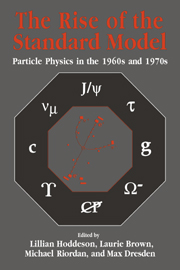Book contents
- Frontmatter
- Contents
- Contributors
- Editors' Acknowledgments
- Photographs of the Symposium
- Abbreviations and Acronyms
- Mathematical Notation
- Part One Introduction
- Part Two Quarks and Leptons
- Part Three Toward Gauge Theories
- Part Four Accelerators, Detectors, and Laboratories
- Part Five Electroweak Unification
- Part Six The Discovery of Quarks and Gluons
- Part Seven Personal Overviews
- 35 Quarks, Color, and QCD
- 36 The Philosopher Problem
- 37 Should We Believe in Quarks and QCD?
- 38 A Historical Perspective on the Rise of the Standard Model
- Index
37 - Should We Believe in Quarks and QCD?
Published online by Cambridge University Press: 03 February 2010
- Frontmatter
- Contents
- Contributors
- Editors' Acknowledgments
- Photographs of the Symposium
- Abbreviations and Acronyms
- Mathematical Notation
- Part One Introduction
- Part Two Quarks and Leptons
- Part Three Toward Gauge Theories
- Part Four Accelerators, Detectors, and Laboratories
- Part Five Electroweak Unification
- Part Six The Discovery of Quarks and Gluons
- Part Seven Personal Overviews
- 35 Quarks, Color, and QCD
- 36 The Philosopher Problem
- 37 Should We Believe in Quarks and QCD?
- 38 A Historical Perspective on the Rise of the Standard Model
- Index
Summary
There are two questions I want to address in this chapter. First, what is the evidential status of entities such as quarks and theories such as quantum chromodynamics, or QCD? In particular, is there a special problematic associated with just these entities and this theory?
But that leads to the second question of a more general nature: What is the evidential status of any theoretical entities and their properties and relations as encoded in some area of theoretical discourse? The second question touches on a central concern of general philosophy of science. But let me start with the first question.
Quarks first came into the physics vocabulary via the fundamental representation of the SU(3) symmetry introduced into hadronic physics in 1964 by Murray Gell-Mann and George Zweig. The actual known particles were associated with higher-dimensional representations of the symmetry, such as the octet, the original Eightfold Way. The quarks were at first a somewhat shadowy substratum for building up the particles actually observed in Nature (in particular the famously predicted Ω−). I say shadowy because one could, for example, abstract from the quarks an algebra of currents, take this algebra seriously and discard the quarks – throwing away the ladder after making the ascent, so to speak. But then, in the late 1960s, came the deep-inelastic electron scattering experiments at SLAC, the verification of Bjorken scaling, and its immediate interpretation in terms of pointlike constituents, the parton model of the nucleons.
- Type
- Chapter
- Information
- The Rise of the Standard ModelA History of Particle Physics from 1964 to 1979, pp. 637 - 644Publisher: Cambridge University PressPrint publication year: 1997



